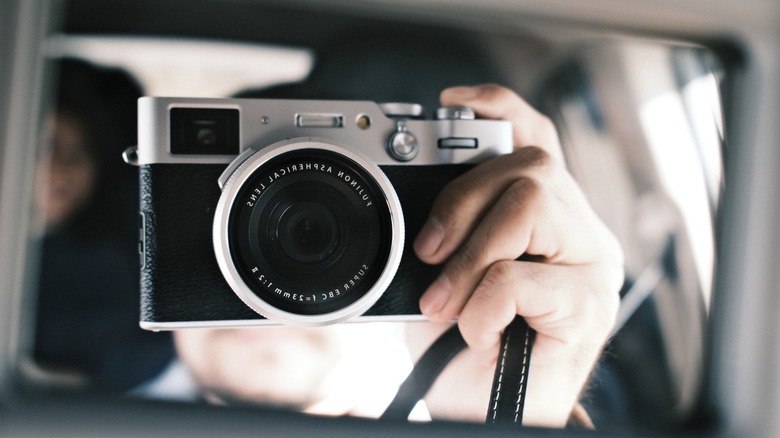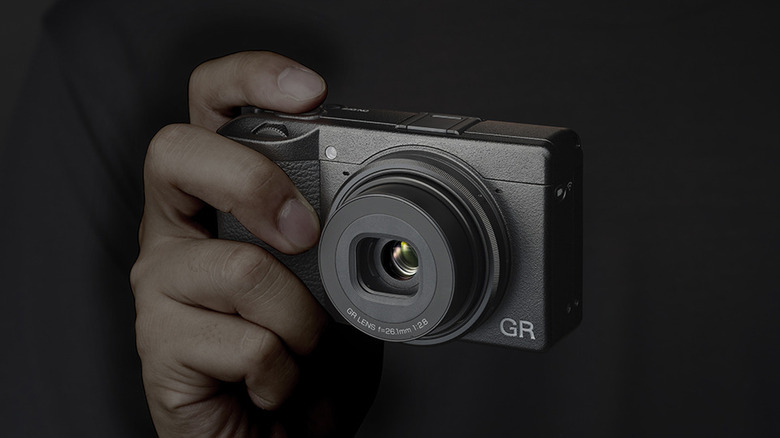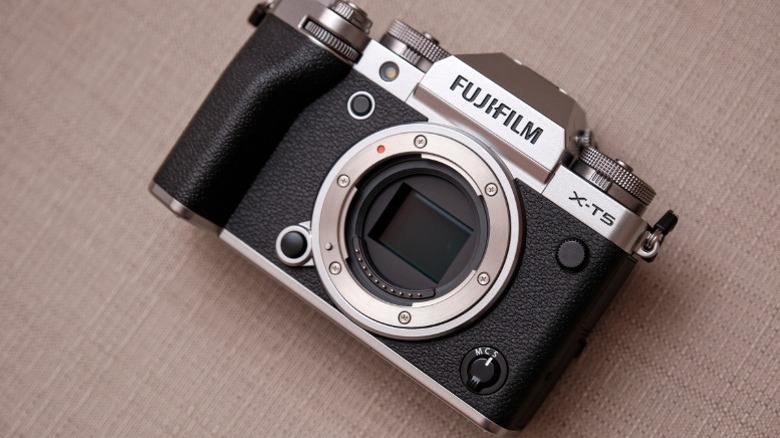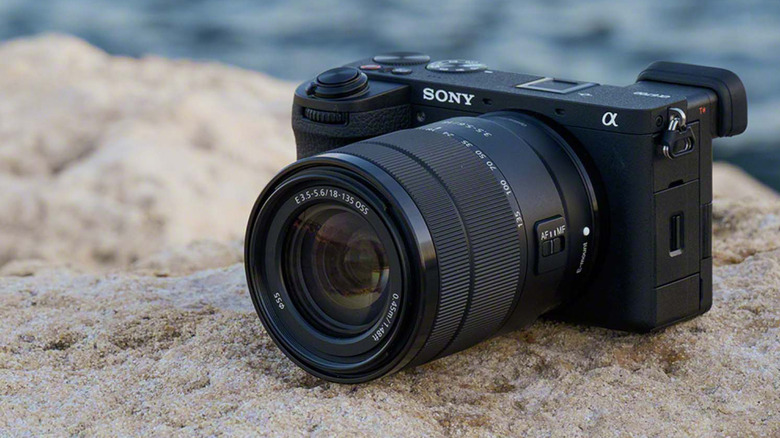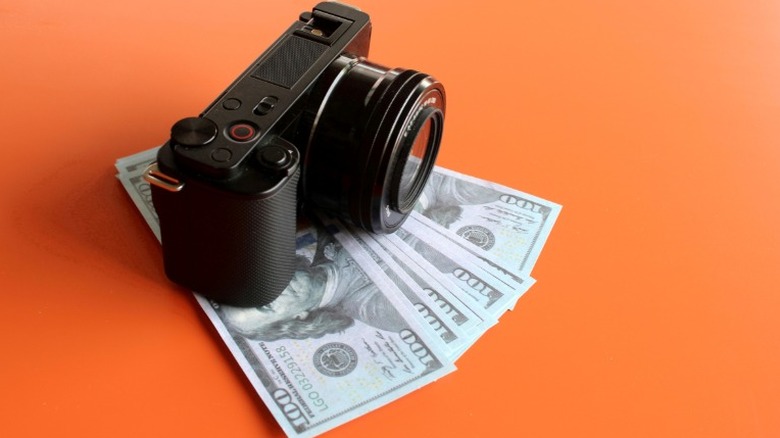3 Top-Rated Alternatives To The Fujifilm X100VI
We may receive a commission on purchases made from links.
Launched in February 2024, the Fujifilm X100VI grew in popularity so much that the company is still hard at work fulfilling its orders. The mirrorless camera sports a 40-megapixel APS-C sized cropped sensor with a 35mm equivalent fixed-lens that delivers a maximum aperture of F/2.0. This gives your images the smooth bokeh look that most smartphones mimic using software processing nowadays.
Scoring a 9/10 rating in SlashGear's review of the Fujifilm X100VI, it's easy to see why demand for this camera has skyrocketed. Not only is it pocket-sized and pretty, but it churns out really solid-looking images, especially when combined with Fujifilm's film simulation modes. With decades of experience in manufacturing optics as well as photographic film, Fujifilm's cameras emulate the distinct look of classic film stocks.
The camera is often out of stock on official channels. Given its scarcity, if you want one, it's smart to start looking for other options. This list contains some of the most popular Fujifilm X100VI alternatives you can buy. These cameras are all highly rated by experts in the industry, and you can find out more about our methodology at the end of this read.
Ricoh GR IIIx: An affordable alternative
Earning a score of 8/10 in our review of the Ricoh GR IIIx, we were most impressed by the camera's low light performance and compact build. It has a couple of built-in color presets including B&W, retro, and monotone. Like Fujifilm's film simulation mode, these filters can prove to be an effortless way to get preprocessed JPEGs out of your camera — though you would want to shoot in RAW if you'll be taking these into Lightroom for further tweaking.
The Ricoh GR IIIx features a 24-megapixel APS-C sized sensor with an f/2.8 lens that delivers an equivalent field of view of 40mm. This makes it a great option for capturing subjects that are decently far — settings like street photography or even portraits should feel natural with the Ricoh GR IIIx. The camera is pocketable, but makes some sacrifices to attain its small stature. Namely, you bid farewell to the built-in flash and viewfinder, though the LCD touchscreen is fairly large.
A notable downside of this camera is its lackluster video performance. With 1080p being the only resolution it can shoot, this wouldn't be our recommendation if videography falls into your requirements. Despite launching for a hundred bucks cheaper, the Ricoh GR IIIx currently sells at $1,046 and has a 4.8-star rating on B&H — making it a worthy and slightly more affordable alternative to the Fujifilm X100VI.
Fujifilm X-T5: Comes with film simulation
Understanding Fujifilm's camera line-up can take some getting used to — the X-2HS and X-2H are the company's top-end shooters, while the X-T200 and X-E4 represent its entry-level segment. Situated somewhere in the middle is the Fujifilm X-T5, which, at $1,699, is a photography-first APS-C camera that shares a lot of the goodness that the X100VI is known for. The camera features a 40-megapixel X-Trans 5 HR CMOS sensor, but unlike the X100VI, the Fujifilm X-T5 doesn't come with a fixed lens.
This means you can swap in lenses that specialize in different kinds of photography, be it zoom, wide-angle, or macro. While having a simple point-and-click solution like the X100VI can prove to be quick and easy, the versatility you get with swappable lenses remains unmatched. The X-T5 also features a weather-resistant body — and with an appropriately weather-sealed lens, you can go on extreme adventures with the camera.
Much like the X100VI, the Fujifilm X-T5 comes with a handful of film simulation modes, making it a suitable alternative if that's the one feature you don't want to compromise on. Digital Photography Review gave the camera an overall score of 90%, factoring in the X-T5's lackluster video performance. The camera comes in two colorways — a stealth black, or one with a silver trim that gives it the signature retro look that most Fujifilm cameras are known for.
Sony A6700: For the videographers
Sony makes some of the most popular mirrorless cameras you can buy, and its alpha-series brings interchangeable-lens options at nearly every price point. At $1,399, you can pick up the Sony Alpha 6700, which is an APS-C-cropped mirrorless camera that brings the same compact luxury that the Fujifilm X100VI is widely acclaimed for.
The 26-megapixel CMOS sensor helps the A6700 capture detailed images regardless of the amount of light it's given. The mirrorless camera uses an electronic viewfinder, and features a 3-inch fully articulating LCD screen — which can help immensely in shot framing or during vlogs. A key feature of the Sony A6700 over the Fujifilm X100VI is its E-mount system, which unlocks access to a great variety of lenses. Also, unlike the Fujifilm, the A6700 is highly capable in the video department, with the ability to shoot up to 4K at 120fps — all the while enjoying Sony's excellent autofocus.
Engadget called the A6700 "Sony's best APS-C camera yet," giving it an overall score of 88/100. A notable downside of going the Sony route would be missing out on Fujifilm's film simulation presets. However, Sony's own S-Log can help preserve a good amount of information in the captured images, which you can then tweak during post-production. Lastly, you do need to factor in future expenses, since the listed price for the camera doesn't include any lenses.
How we selected cameras for this list
The cameras on this list were selected based on their similarities to the Fujifilm X100VI in terms of compactness and processing power. All three mirrorless cameras feature an APS-C sized sensor and are highly rated by experts in the industry. Publications like Digital Photography Review and Engadget conduct thorough testing of these products and are a trustworthy source for consumer electronics such as phones and cameras.
Given their similarities, the last-gen Fujifilm X100V would have been a perfectly good alternative to the X100VI — only if it was in stock and not inflated on third-party marketplaces. Fortunately, if you prefer the Fujifilm look and respect its film simulation modes, the X-T5 would offer the closest experience. Otherwise, the fixed-lens of the Ricoh GR IIIx brings a sense of compactness and ease of use that most interchangeable-lens cameras can't offer. If you capture a lot of videos using your camera, then the Sony A6700 is the better of the three.
